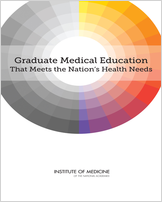NCBI Bookshelf. A service of the National Library of Medicine, National Institutes of Health.
Today's physician education system produces trained doctors with strong scientific underpinnings in biological and physical sciences as well as supervised practical experience in delivering care. Significant financial public support underlies the graduate-level training of the nation's physicians. Two federal programs--Medicare and Medicaid--distribute billions each year to support teaching hospitals and other training sites that provide graduate medical education.
Graduate Medical Education That Meets the Nation's Health Needs is an independent review of the goals, governance, and financing of the graduate medical education system. This report focuses on the extent to which the current system supports or creates barriers to producing a physician workforce ready to provide high-quality, patient-centered, and affordable health care and identifies opportunities to maximize the leverage of federal funding toward these goals. Graduate Medical Education examines the residency pipeline, geographic distribution of generalist and specialist clinicians, types of training sites, and roles of teaching and academic health centers.
The recommendations of Graduate Medical Education will contribute to the production of a better prepared physician workforce, innovative graduate medical education programs, transparency and accountability in programs, and stronger planning and oversight of the use of public funds to support training. Teaching hospitals, funders, policy makers, institutions, and health care organizations will use this report as a resource to assess and improve the graduate medical education system in the United States.
Contents
- THE NATIONAL ACADEMIES
- COMMITTEE ON THE GOVERNANCE AND FINANCING OF GRADUATE MEDICAL EDUCATION
- Reviewers
- Foreword
- Acknowledgments
- Summary
- 1. Introduction
- 2. Background on the Pipeline to the Physician Workforce
- 3. GME Financing
- 4. Governance
- 5. Recommendations for the Reform of GME Financing and Governance
- Appendixes
This study was supported by Contract No. 101053-0009 between the National Academy of Sciences and ABIM Foundation; Contract No. 101053-0013 Aetna Foundation; Contract No. 101053-0014 The California Endowment; Contract No. 101053-0002 California HealthCare Foundation; Contract No. 101053-0003 The Commonwealth Fund; Contract No. 101053-0012 East Bay Community Foundation; Contract No. 101053-0010 Health Resources and Services Administration; Contract No. 101053-0006 Jewish Healthcare Foundation; Contract No. 101053-0001 Josiah Macy Jr. Foundation; Contract No. 101053-0007 Kaiser Permanente Institute for Health Policy; Contract No. 101053-0005 The Missouri Foundation for Health; Contract No. 101053-0004 Robert Wood Johnson Foundation; Contract No. 101053-0008 UnitedHealth Group Foundation; and Contract No. 101053-0011 U.S. Department of Veterans Affairs. Any opinions, findings, conclusions, or recommendations expressed in this publication are those of the author(s) and do not necessarily reflect the views of the organizations or agencies that provided support for the project.
Suggested citation:
IOM (Institute of Medicine). 2014. Graduate medical education that meets the nation's health needs. Washington, DC: The National Academies Press.
NOTICE: The project that is the subject of this report was approved by the Governing Board of the National Research Council, whose members are drawn from the councils of the National Academy of Sciences, the National Academy of Engineering, and the Institute of Medicine. The members of the committee responsible for the report were chosen for their special competences and with regard for appropriate balance.
- NLM CatalogRelated NLM Catalog Entries
- The impact of graduate medical education financing policies on pediatric residency training.[Pediatrics. 1998]The impact of graduate medical education financing policies on pediatric residency training.Bazell C, Salsberg E. Pediatrics. 1998 Apr; 101(4 Pt 2):785-92; discussion 793-4.
- Review Financing graduate medical education to meet the needs of children and the future pediatrician workforce.[Pediatrics. 2008]Review Financing graduate medical education to meet the needs of children and the future pediatrician workforce.American Academy of Pediatrics Committee on Pediatric Workforce, Shipman SA, Pan RJ. Pediatrics. 2008 Apr; 121(4):855-61.
- Envisioning a Future Governance and Funding System for Undergraduate and Graduate Medical Education.[Acad Med. 2015]Envisioning a Future Governance and Funding System for Undergraduate and Graduate Medical Education.Gold JP, Stimpson JP, Caverzagie KJ. Acad Med. 2015 Sep; 90(9):1224-30.
- Academic medicine: a key partner in strengthening the primary care infrastructure via teaching health centers.[Acad Med. 2013]Academic medicine: a key partner in strengthening the primary care infrastructure via teaching health centers.Rieselbach RE, Crouse BJ, Neuhausen K, Nasca TJ, Frohna JG. Acad Med. 2013 Dec; 88(12):1835-43.
- Review Financing radiology graduate medical education: today's challenges.[J Am Coll Radiol. 2006]Review Financing radiology graduate medical education: today's challenges.Otero HJ, Ondategui-Parra S, Erturk SM, Ros PR. J Am Coll Radiol. 2006 Mar; 3(3):207-12.
- Graduate Medical Education That Meets the Nation's Health NeedsGraduate Medical Education That Meets the Nation's Health Needs
- The Birth, Assembly, and Death of Proteins - Molecular Biology of the CellThe Birth, Assembly, and Death of Proteins - Molecular Biology of the Cell
- KRT31 keratin 31 [Homo sapiens]KRT31 keratin 31 [Homo sapiens]Gene ID:3881Gene
- 3881[uid] AND (alive[prop]) (1)Gene
- LINC02336 long intergenic non-protein coding RNA 2336 [Homo sapiens]LINC02336 long intergenic non-protein coding RNA 2336 [Homo sapiens]Gene ID:105370309Gene
Your browsing activity is empty.
Activity recording is turned off.
See more...
